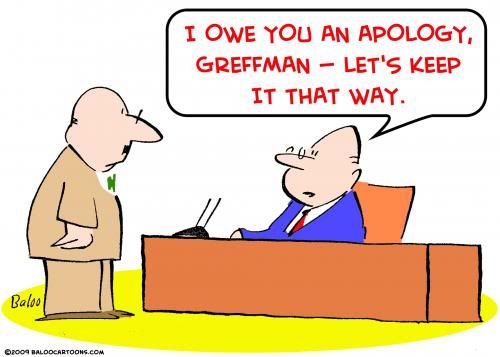
image copyright: toonpool
I’m sorry.
Two words in the English language that are uttered many times, not only from me, but from others too.In the social space, complaints, issues and irritation are conveyed in real time, and patience isn’t a virtue that many have. This further fuels frustration and causes even more tweets, blog posts and complaints.
Brands are being counseled to apologize first, figure out what went wrong and try to make it right. Although the model “the customer is always right” has been around for awhile, has it gotten out of hand? A crap product is a crap product, no matter what the business model is.
When did we:
- Shift the customer service model to expect immediate reaction, not aware of legal channels or traditional company approval?
- Feel outraged when the problem was solved and no type of fiscal refund or free product was given?
- Decide to counsel clients to always respond, instead of evaluating first?
Evaluation
Determine whether the brand is just gathering or actively listening
This is a crucial first step in the process. Many might protest that just gathering information and monitoring is defeating the purpose of the social space. Why it’s not a long term solution, it also helps to make sure that a.) the brand is comfortable on the type of channels they will be communicating on/observing; b.) that the agencies/internal people have time to set up the education foundation
Paid v. Free Measuring Tools
This is a post in itself, but I have a hard pressed rule when it comes to recommending measurement tools for not only our clients, but for the agency itself. Each one is different, and each one might have a combination of tools to get the job done. There is no magic button or band-aid that will pop out a monthly measurement report. There are amazing paid tools out there in Alterian, Radian6 and Sysomos, among others. If you can’t justify the cost of the product with what you’re using it for, it’s not worth it. Every client has different needs, which equals different “bells and whistles.” How do I know this? It’s the first question I ask.
The question: “What do you want to accomplish in 3, 6, 9 and 12 months?”
It might seem a bit broad, but I prefer pyramid approaches to benchmarking results. That’s the thing – if you aren’t starting out with a question, then breaking it into specifics BASED on the client needs, you aren’t going to find the right tool. If you’re actively responding on behalf of a client, that’s different than just monitoring. That’s what free v. paid comes down to – and then you can determine best fits. For me, education of the tool on the vendor side is an important piece that helps make me recommend one over another. Are training classes available? How responsive are they when I have questions/need reports? Is the tool hitting all measurable objectives I’ve set for the client?
Once a brand determines that they would like to actively respond, then it’s time to further construct your evaluation and response methods.
Response
There isn’t a hard and fast fool-proof solution to response. Even though automated sentiment is hot, there is still a need to do a bit of manual work in the backend. Technology, while great, doesn’t have all of the inside information on the inner workings of a company. That’s what people are for. They can evaluate and see if a person will have impact on their potential audience/demographic, or if they tend to be a person who complains a lot. Does the person have a negative approach? I’ve found that brands usually respond if I say, “I seem to be having an issue on my end – do you know of any solutions? Happy to chat via phone. TY in advance!” instead of “You’re crap, I want my money back” type argument. I think the Air Force has a brilliant model for evaluation/response when determining who to respond to.
Because, yes, not every single person is going to get a response. From a business model standpoint, it seems to be a big resource and has a lot of finance devoted to it. Do many companies have the ability to have a team solely devoted to responding online in this type of economy? From my experience, no. Does it happen? Yes.
Each approach and response will be different based on the client. Review the crisis communications plan, update it every 6 months and include SM tactics, and have a playbook that dictates:
Who will respond on behalf on the brand for each situation
- What type of situations warrant a response
- Is your legal department involved? What approval channels are necessary?
- How the brand determines sentiment
- What hours of the day the brand will response
- Window of response time
- Example scenarios
Future Clients/Employers
The thing is – every time you complain about a brand or experience, people are watching. Not only are future employers reading your stream, but former colleagues and present bosses as well. A PR agency executive told me that she scans Twitter streams, and if she sees someone who cusses, complains a lot and goes on rants, she won’t hire them. Why? That attitude isn’t something she wants to put in front of a client, and it’s the only thing she can go off of.
At the same time, new business is a large part of every agency. If you complain about a brand, it’s probably not going to be one that would be open to a new business pitch. While I believe that complaints can be constructive, they have to be worded carefully because of the tone issue in this space.
What are your thoughts? How would you flesh out your evaluation and response? Do we apologize too much?




